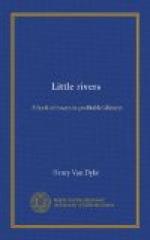I believe the guide-book says that they are formed of carbonate of lime and carbonate of magnesia in chemical composition; but even if this be true, it need not prejudice any candid observer against them. For the simple and fortunate fact is that they are built of such stone that wind and weather, keen frost and melting snow and rushing water have worn and cut and carved them into a thousand shapes of wonder and beauty. It needs but little fancy to see in them walls and towers, cathedrals and campaniles, fortresses and cities, tinged with many hues from pale gray to deep red, and shining in an air so soft, so pure, so cool, so fragrant, under a sky so deep and blue and a sunshine so genial, that it seems like the happy union of Switzerland and Italy.
The great highway through this region from south to north is the Ampezzo road, which was constructed in 1830, along the valleys of the Piave, the Boite, and the Rienz—the ancient line of travel and commerce between Venice and Innsbruck. The road is superbly built, smooth and level. Our carriage rolled along so easily that we forgot and forgave its venerable appearance and its lack of accommodation for trunks. We had been persuaded to take four horses, as our luggage seemed too formidable for a single pair. But in effect our concession to apparent necessity turned out to be a mere display of superfluous luxury, for the two white leaders did little more than show their feeble paces, leaving the gray wheelers to do the work. We had the elevating sense of traveling four-in-hand, however—a satisfaction to which I do not believe any human being is altogether insensible.
At Longarone we breakfasted for the second time, and entered the narrow gorge of the Piave. The road was cut out of the face of the rock. Below us the long lumber-rafts went shooting down the swift river. Above, on the right, were the jagged crests of Monte Furlon and Premaggiore, which seemed to us very wonderful, because we had not yet learned how jagged the Dolomites can be. At Perarolo, where the Boite joins the Piave, there is a lump of a mountain in the angle between the rivers, and around this we crawled in long curves until we had risen a thousand feet, and arrived at the same Hotel Venezia, where we were to dine.
While dinner was preparing, the Deacon and I walked up to Pieve di Cadore, the birthplace of Titian. The house in which the great painter first saw the colours of the world is still standing, and tradition points out the very room in which he began to paint. I am not one of those who would inquire too closely into such a legend as this. The cottage may have been rebuilt a dozen times since Titian’s day; not a scrap of the original stone or plaster may remain; but beyond a doubt the view that we saw from the window is the same that Titian saw. Now, for the first time, I could understand and appreciate the landscape-backgrounds of his pictures. The compact masses of mountains, the bold, sharp forms, the hanging rocks of cold gray emerging from green slopes, the intense blue aerial distances—these all had seemed to be unreal and imaginary—compositions of the studio. But now I knew that, whether Titian painted out-of-doors, like our modern impressionists, or not, he certainly painted what he had seen, and painted it as it is.




